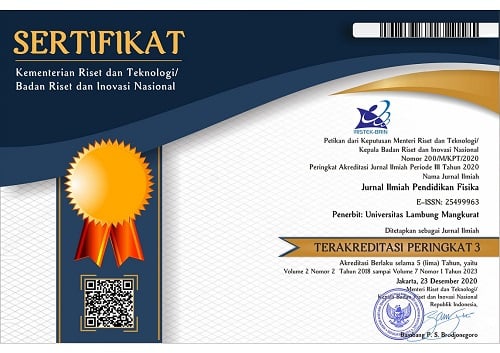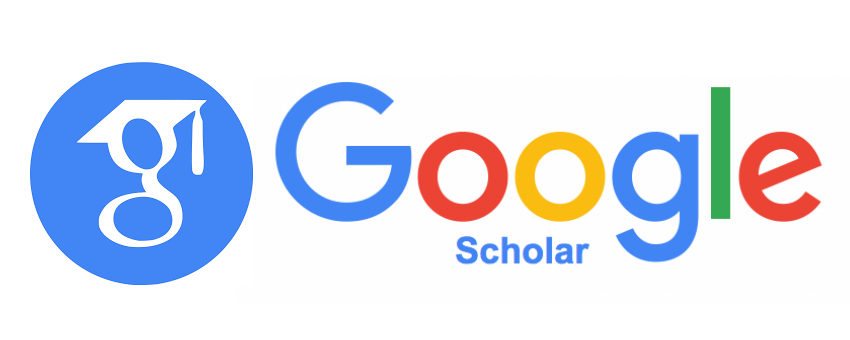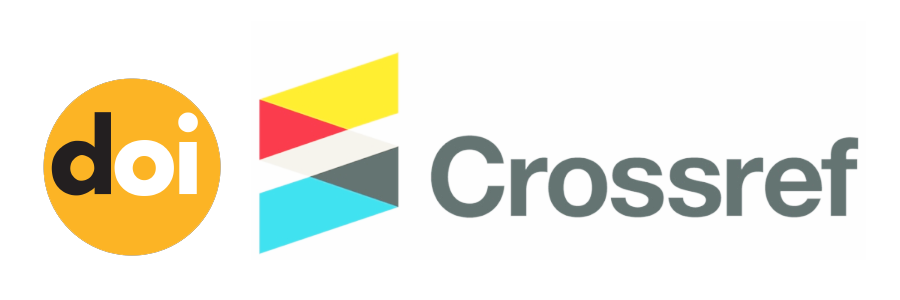Validation of ExPRession Learning Model-based E-Worksheet Assisted with Heyzine to Construct Computational Thinking Skill
Abstract
This study aims to determine the validity of the e-worksheet based on the Expression Learning model to construct students' computational skills in direct current electric circuit material. This research was development research using Design, Development, and Research (DDR) which consisted of the analysis, design, development, and evaluation stages and used the mixed method to analyze the data. The instrument used to determine the validity of the developed e-worksheet product was an e-worksheet validation sheet. The e-worksheet validation sheet consisted of product and constructs design validity sheets which were validated by five experts who judged that the developed e-worksheet is very valid, with an average score for the construct validation test of 91.5% and an average score for design test validation of 89%. The research findings showed that ExPRession learning model-based e-worksheet assisted with Heyzine to construct computational thinking skill in direct current electric circuits material is very valid. This study provides evidence that applying the ExPRession learning model to the e-worksheet can construct students' computational thinking skills as one of the skills needed in the 21st century by teaching students the use of Microsoft Excel.
Keywords
Full Text:
PDFReferences
Andrian, Y., & Rusman, R. (2019). Implementasi pembelajaran abad 21 dalam kurikulum 2013. Jurnal Penelitian Ilmu Pendidikan, 12(1), 14-23
Ansori, M. (2020). Pemikiran komputasi (computational thinking) dalam pemecahan masalah. Dirasah : Jurnal Studi Ilmu Dan Manajemen Pendidikan Islam, 3(1), 111–126. https://doi.org/10.29062/dirasah.v3i1.83
Arikunto, S. (2011). Prosedur penelitian suatu pendekatan praktek. Bumi Aksara.
Budiansyah, A. (2020). Nadiem usung computational thinking jadi kurikulum, apa itu?. https://www.cnbcindonesia.com/tech/20200218151009-37-138726/nadiem-usung-computational-thinking-jadi-kurikulum-apa-itu. 23 September 2021 (20.03).
Collins, J. (2002). Teaching and learning with multimedia. In Teaching and Learning with Multimedia. https://doi.org/10.4324/9780203441305
Creswell, J. W. (2003). Research design qualitative, quantitative, and mixed methods approaches second edition (Second Edi). Sage Publication, Inc.
Fakhriyah, F., Masfuah, S., & Mardapi, D. (2019). Developing scientific literacy-based teaching materials to improve students’ computational thinking skills. Jurnal Pendidikan IPA Indonesia, 8(4), 482–491. https://doi.org/10.15294/jpii.v8i4.19259
Fakhriyah, F., Masfuah, S., & Roysa, M. (2017). The characteristics of scientific literacy-based teaching materials for developing computational thinking skills. Proceeding of ICMSE, 1–6. https://journal.unnes.ac.id/sju/index.php/icmse/article/view/23704
Ghozian, M., Ahsan, K., Nur, A., & Prabowo, A. (2022). Desain web-apps-based student worksheet dengan pendekatan computational thinking pada pembelajaran matematika di masa pandemi | PRISMA, Prosiding Seminar Nasional Matematika. 4(2021), 344–352. https://journal.unnes.ac.id/sju/index.php/prisma/article/view/44971
Good, J. A. Y. & P. M. (2017). Computational thinking in computer science classrooms: Viewpoints from CS Educators.
Haqsari, R. (2014). Pengembangan dan analisis e-lkpd (elektronik -
Lembar kerja peserta didik) berbasis multimedia pada materi mengoperasikan software spreadsheet. Skripsi, Jurusan Pendidikan Teknik Informatika Fakultas Keguruan dan Ilmu Pendidikan Universitas Negeri Yogyakarta, Yogyakarta.
Hartini, S., Misbah, M., Dewantara, D., Oktovian, R. A., & Aisyah, N. (2017). Developing learning media using online prezi into materials about optical equipments. Jurnal Pendidikan IPA Indonesia, 6(2), 313-317
Haryanto, Asrial, & Ernawati, M. D. W. (2020). E-worksheet for science processing skills using kvisoft flipbook. International Journal of Online and Biomedical Engineering, 16(3), 46–58. https://doi.org/10.3991/IJOE.V16I03.12381
Kaymakci, S. (2012). A Review of Studies on Worksheets in Turkey. Online Submission, 1, 57–64.
Khasyyatillah, I., & Osman, K. (2019). The development of ct-s learning module on the linear motion topic to promote computational thinking thinking. Journal of Educational Sciences, 3(3), 270. https://doi.org/10.31258/jes.3.3.p.270-280
Kivunja, C. (2015). Unpacking the information, media, and technology skills domain of the new learning paradigm. International Journal of Higher Education, 4(1), 166–181. https://doi.org/10.5430/ijhe.v4n1p166
Lee, C. (2014). Worksheet usage, reading achievement, classes’ lack of readiness, and science achievement: A cross-country comparison. 2(2), 96–106.
Leon-abao, E. De, Ed, D., Boholano, H. B., Ed, D., Dayagbil, F. T., & Ed, D. (2015). Engagement to social networking : Challenges and opportunities to educators. European Scientific Journal, 11(16), 173–191.
Lestari, P. C., Miriam, S., & Misbah, M. (2021). Science literacy-based sound wave e-worksheet: Validity aspects. In Journal of Physics: Conference Series, 2104(1), 012010. IOP Publishing.
Mayer, R. (1999). Research-based principles for the design of instructional messages: The case of multimedia explanations. Document Design, 1(1), 7–19. https://doi.org/10.1075/dd.1.1.02may
Misbah, M., Dewantara, D., Hasan, S. M., & Annur, S. (2018). The
development of student worksheet by using Guided Inquiry Learning Model to train student's scientific attitude. Unnes Science Education Journal, 7(1).
Muliyati, D., Tanmalaka, A. S., Ambarwulan, D., Kirana, D., & Permana, H. (2020). Train the computational thinking skill using problem-based learning worksheet for undergraduate physics student in computational physics courses. Journal of Physics: Conference Series, 1521(2). https://doi.org/10.1088/1742-6596/1521/2/022024
Nelson, C. A., de Haan, M., & Thomas, K. M. (2015). The development of object recognition. Neuroscience of Cognitive Development, 18, 107–118. https://doi.org/10.1002/9780470939413.ch8
Noftiana, N., Nasir, M., & Islami, N. (2019). Developmental scratch-based online learning media in dynamic electric dynamic topic to increase students concept understanding in students junior high school. Journal of Physics: Conference Series, 1351(1).
https://doi.org/10.1088/1742-6596/1351/1/012014
Partnership for 21st Century - A Network of Battelle for Kids [P21]. (2019). Framework for 21st Century Learning. Partnership for 21st Century Learning. http://static.battelleforkids.org/documen%0Ats/p21/P21_Framework_
Brief.pdf
Redhana, I. W. (2019). Mengembangkan keterampilan abad ke-21 dalam pembelajaran kimia. Jurnal Inovasi Pendidikan Kimia, 13(1).
Richey, R. C., dan Klein, J. D. (2007). Design and development research. Lawrence Erlbaum Associates, Inc.
Rusilowati, A. (2012). Profil kesulitan belajar fisika pokok bahasan kelistrikan siswa sma di kota semarang. Jurnal Pendidikan Fisika Indonesia, 4(2), 1–1. https://doi.org/10.15294/jpfi.v4i2.163
Safrina, I., Maknun, J., & Hasanah, L. (2017). Analysis of student’s
skills on the concept dynamic electricity. Journal of Physics: Conference Series, 895(1). https://doi.org/10.1088/1742-6596/895/1/012104
Safrina, I., Maknun, J., & Hasanah, L. (2019). How to improve student’s skill on the concept dynamic electricity? Journal of Physics: Conference Series, 1157(3). https://doi.org/10.1088/1742-6596/1157/3/032035
Sinaga, M. (2019). Implementation of innovative learning material to improve students competence on chemistry. Indian Journal of Pharmaceutical Education and Research (IJPER), 53(1), 28–41.
Sudjana, S. (2005). Metoda Statistika (6th Editio). PT Tarsito Bandung.
Wang, J., Jou, M., Lv, Y., & Huang, C.-C. (2018). An investigation on teaching performances of model-based flipping classroom for physics supported by modern teaching technologies. Computers in Human Behavior, 84, 36–48.
Yunanto, D., Herlina, S., Boediono, A.P., & Fajri, M.S. 2018. Kreatif dan inovatif di era revolusi industri 4.0. Media Pustakawan. 8, 1-56.
DOI: https://doi.org/10.20527/jipf.v7i1.6329
Refbacks
- There are currently no refbacks.
Indexed by: Jurnal Ilmiah Pendidikan Fisika is licensed under a creative commons attribution-share alike 4.0 international license
Statistics Counter |
















